Lemon Badger G Auto
RSP 13215
Grower: Wisconsin Crop Innovation Center
General Information
- Accession Date
- September 18, 2024
- Reported Plant Sex
- Female
- Report Type
- Whole-Genome Sequencing
The strain rarity visualization shows how distant the strain is from the other cultivars in the Kannapedia database. The y-axis represents genetic distance, getting farther as you go up. The width of the visualization at any position along the y-axis shows how many strains there are in the database at that genetic distance. So, a common strain will have a more bottom-heavy shape, while uncommon and rare cultivars will have a visualization that is generally shifted towards the top.
Chemical Information
Cannabinoid and terpenoid information provided by the grower.
Cannabinoids
No information provided.
Terpenoids
No information provided.
Genetic Information
- Plant Type
- Unknown
File Downloads
The bell curve in the heterozygosity visualization shows the distribution of heterozygosity levels for cannabis cultivars in the Kannapedia database. The green line shows where this particular strain fits within the distribution. Heterozygosity is associated with heterosis (aka hybrid vigor) but also leads to the production of more variable offspring. When plants have two genetically different parents, heterozygosity levels will be higher than if it has been inbred or backcrossed repeatedly.
The ratio of reads mapped to Y-contigs to reads mapped to the whole Cannabis genome (Y-ratios) has been demonstrated to be strongly correlated with plant sex typing. This plot shows the distribution of Y-ratios for all samples in our database which were sequenced with the same method (panel or WGS) as this sample and where this sample falls in the distribution.
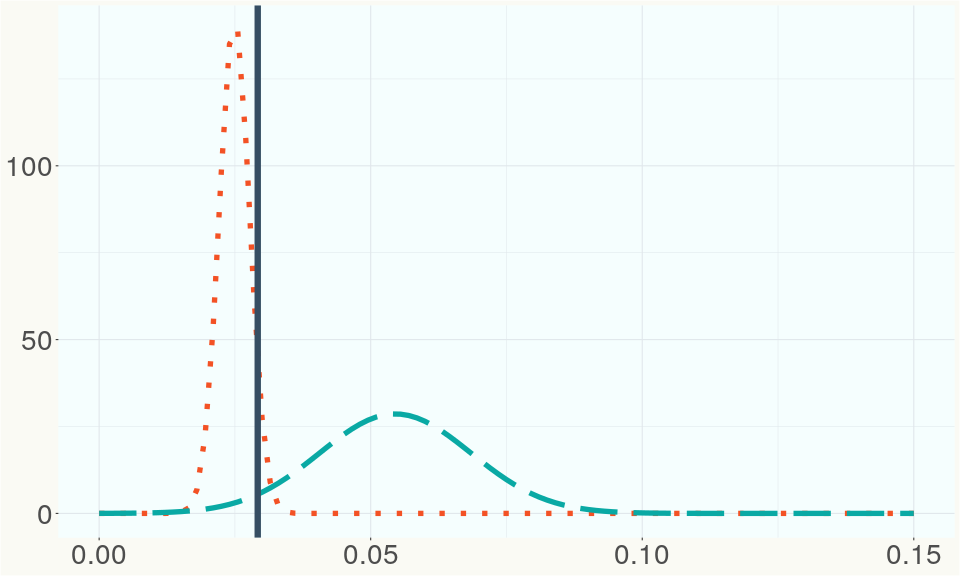
This chart represents the Illumina sequence coverage over the Bt/Bd allele. These are the three regions in the cannabis genome that impact THCA, CBDA, CBGA production. Coverage over the Active CBDAS gene is highly correlated with Type II and Type III plants as described by Etienne de Meijer. Coverage over the THCA gene is highly correlated with Type I and Type II plants but is anti-correlated with Type III plants. Type I plants require coverage over the inactive CBDA loci and no coverage over the Active CBDA gene. Lack of coverage over the Active CBDA and Active THCA allele are presumed to be Type IV plants (CBGA dominant). While deletions of entire THCAS and CBDAS genes are the most common Bt:Bd alleles observed, it is possible to have plants with these genes where functional expression of the enzyme is disrupted by deactivating point mutations (Kojoma et al. 2006).
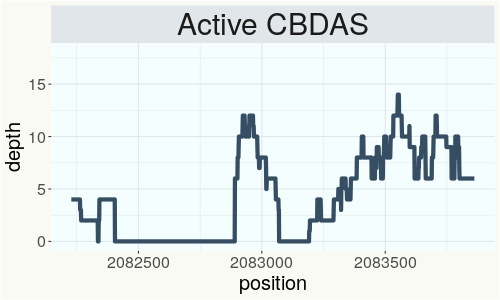
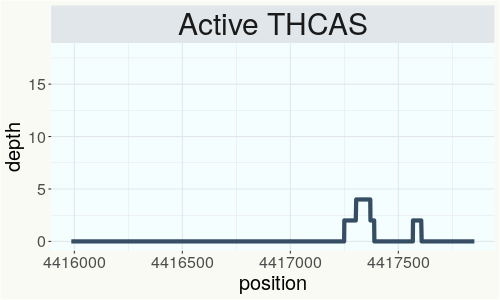
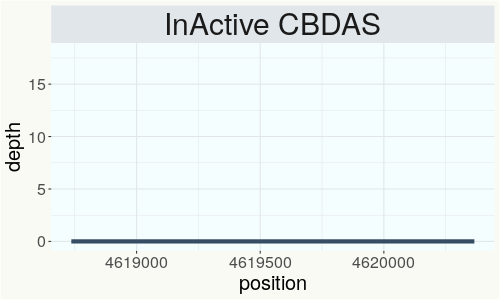
This chart represents the Illumina sequence coverage over the CBCA synthase gene.
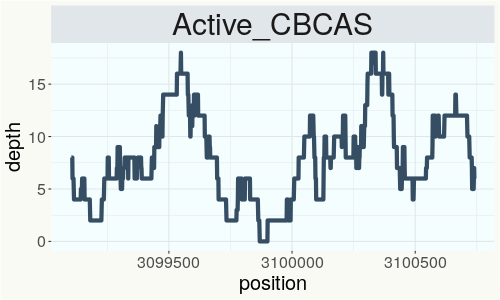
Variants (THCAS, CBDAS, and CBCAS)
No variants to report
Variants (Select Genes of Interest)
| PHL-2 | c.3202A>C | p.Thr1068Pro | missense variant | moderate | contig2621 | 343245 | A/C |
|
| PHL-2 | c.3209A>G | p.Gln1070Arg | missense variant | moderate | contig2621 | 343252 | A/G | |
| PKSG-4b | c.206T>C | p.Leu69Ser | missense variant | moderate | contig700 | 2724229 | A/G |
|
| PHL-1 | c.2551A>G | p.Thr851Ala | missense variant | moderate | contig1439 | 1487246 | T/C |
Nearest genetic relatives (All Samples)
- 0.258 Badger G (RSP13082)
- 0.265 AC DC G (RSP13216)
- 0.302 RINGO S ANGEL (RSP10085)
- 0.309 CBG Berry (RSP11446)
- 0.312 CBG- 40 (RSP11444)
- 0.313 Joy (RSP11380)
- 0.315 Purple Urkle (RSP12890)
- 0.316 Thank You Jerry (RSP11459)
- 0.320 A5 Haze (RSP12815)
- 0.320 CBG 30 (RSP11447)
- 0.321 Trump x Trump (RSP11466)
- 0.322 T20 Dried (RSP13125)
- 0.325 Rest (RSP11377)
- 0.325 A5 Haze (RSP12816)
- 0.325 Electra (RSP11366)
- 0.328 RKM-2018-026 (RSP11118)
- 0.328 Badger (RSP11614)
- 0.329 Tahoe OG (RSP11189)
- 0.329 Cbot-2019-005 (RSP11133)
- 0.330 CDSD (RSP13084)
Most genetically distant strains (All Samples)
- 0.506 Cherry Blossom (RSP11329)
- 0.501 Cherry Blossom (RSP11306)
- 0.481 Cherry Blossom (RSP11322)
- 0.481 80E (RSP11213)
- 0.477 Brunswick High (RSP11164)
- 0.475 JL 3rd Gen Mother (RSP11214)
- 0.472 Jamaican Lion (RSP12916)
- 0.470 Jamaican Lion (RSP12917)
- 0.466 JL yellow (RSP11075)
- 0.466 Cherry Blossom (RSP11325)
- 0.466 80E (RSP11211)
- 0.464 Cherry Blossom (RSP11330)
- 0.464 JL 4th Gen 4 (RSP11198)
- 0.459 Tanao Sri 46 (RSP11486)
- 0.459 Cherry Blossom (RSP11326)
- 0.458 Cherry Blossom (RSP11315)
- 0.458 Cherry Blossom CBG (RSP11303)
- 0.458 80E (RSP11212)
- 0.454 JL 4th Gen 5 (RSP11199)
- 0.454 Jamaican Lion (RSP12915)
Nearest genetic relative in Phylos dataset
- Overlapping SNPs:
- 8
- Concordance:
- 5
Nearest genetic relative in Lynch dataset
- Overlapping SNPs:
- 8
- Concordance:
- 8
Blockchain Registration Information
- Transaction ID
-
RSP13215-mgc-ots
-certificate - Stamping Certificate
- Download PDF (1.2 MB)
- SHASUM Hash
-
e8206536833adafaea3d0aa2641c078e acd3f5eba78abccc aca28348a85ffb8c